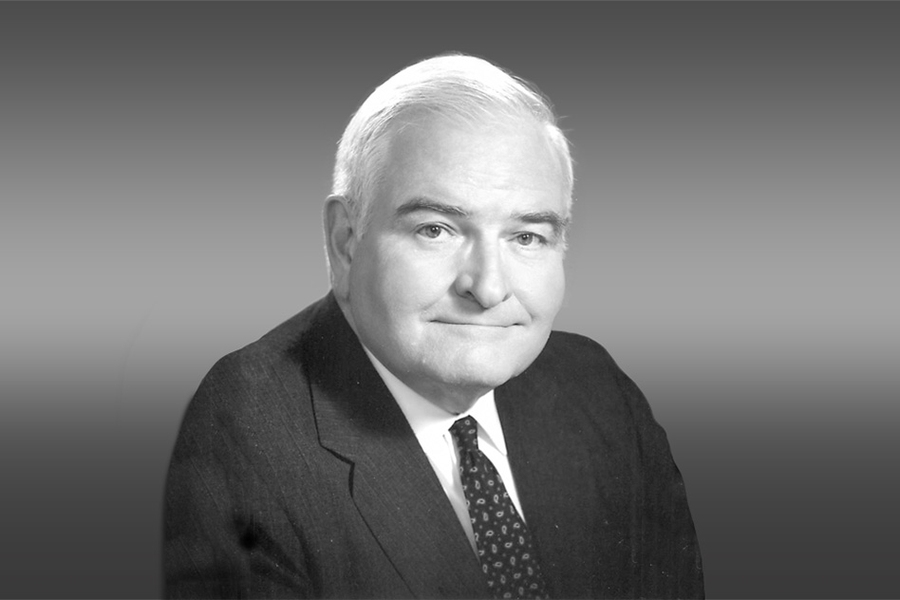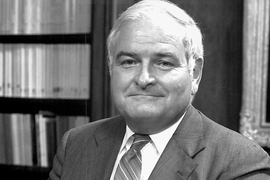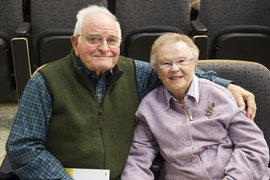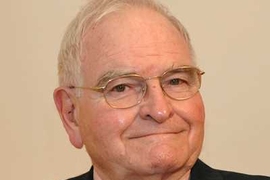Several hundred members of the MIT community attended a spirited and affecting celebration on Thursday of the late Paul Gray ’54, SM ’55, ScD ’60 — paying tribute to the former MIT president who helped transform the Institute’s social fabric, student experience, and scientific ambitions.
Family members, friends, former colleagues, and former students all spoke, depicting Gray as an affable, intellectually curious, down-to-earth leader determined to open up MIT to the world, modernize its curriculum, and add the resources necessary to keep MIT on the frontiers of academic research.
“More than anyone I can think of, Paul shaped the MIT we know today,” said MIT President L. Rafael Reif in his opening remarks at the event, held inside Kresge Auditorium. “When you think of the programs and progress he helped create, it’s impossible to imagine MIT without them.”
Among other things, Gray spearheaded MIT efforts to draw minority students to campus and to increase the number of female students. Gray helped implement MIT’s Undergraduate Research Opportunities Program (UROP), which has become a staple of academic life at MIT, and advocated for the addition of biology to the MIT core curriculum. As president in the 1980s, Gray also worked to open the Whitehead Institute, a cornerstone of MIT’s now-expansive research efforts in the life sciences.
If Gray was ambitious for MIT, he remained personally unpretentious, a leader who was skilled at listening and dealt with people in a genial and straightforward manner.
“Paul was profoundly honest,” Reif said. “He lived by the highest ethical and moral standards.” Moreover, Reif added, “There was a moral unity to his whole life, a unity of purpose and values. He knew who he was, down to the core. That gave him deep personal confidence in every situation. And it gave everyone else perfect confidence that he would always do the right thing. And he always did.”
Gray’s key actions included constructing programs, starting in the late 1960s, that identified and recruited minority students to matriculate at MIT. In so doing, Gray worked extensively with Shirley Ann Jackson ’68 PhD ’73, the first African-American to receive a doctorate from MIT, who has been president of Rensselaer Polytechnic Institute since 1999 and is a life member of the MIT Corporation.
“I’ve always felt an enormous sense of kinship with Paul because we shared important moments of leadership together,” Jackson said in her remarks.
As Jackson recounted, she was one of just two African-American women in her graduating class, something she described as a “lonely” experience. Upon deciding to stay at MIT for graduate school, she became involved in the formation of MIT’s Black Students’ Union, whose requests for more resources led MIT to form its Task Force on Educational Opportunity. Gray helped direct the Institute’s response.
“He quickly demonstrated that he was a true leader, exactly the right, mature person for a turbulent time,” Jackson said. “He took what could have been an adversarial situation, and sometimes it was, and instantly identified our shared objectives. … He immediately grasped that MIT could, and should, be better.”
Jackson, invited to join the Task Force on Educational Opportunity, soon found herself frequently working alongside Gray and observing his empathetic nature. “He was ready to listen, to learn, and to act,” Jackson, adding that the task force “spurred a breathtaking change at MIT,” by developing an array of programs that ultimately opened up the Institute to more minorities and women, among both students and faculty.
Gray’s efforts, Jackson added, were part of a career-long collaboration with his wife, Priscilla King Gray, as they both worked to enhance the Institute’s sense of community.
“Importantly, Paul and Priscilla, as partners, worked to make MIT a more welcoming place, in myriad ways, for everyone,” Jackson said. She added that Gray was “a sounding board, mentor, supporter, and friend, throughout my career.”
In retirement, over the last decade, Gray remained a mentor and sounding board to many at MIT. Susan Hockfield, MIT’s 16th president, who served from 2005 to 2012, recalled Gray as a valued advisor who served as her “first and most essential guide to MIT” when she arrived at the Institute.
As Hockfield noted, Gray’s support for the expansion of bioscience research and teaching at MIT “set conditions in place for the biological, biomedical, biotech explosion at MIT and in Kendall Square,” which has helped keep both locales at the forefront of innovation.
“Thank you, Paul, for bringing us together in support of MIT’s core values: the pursuit of truth, meritocracy, personal integrity, and service to others,” Hockfield said.
“This special place”
Gray was born in Newark, New Jersey, on Feb. 7, 1932, and, growing up, became an eager student whose father encouraged him to tinker with electronic gadgets. Gray earned all three of his MIT degrees in electrical engineering and joined the MIT faculty in 1960. He served as associate dean for student affairs from 1965 to 1967; associate provost from 1969 to 1970; and dean of the School of Engineering from 1970 to 1971.
In the next phase of his career, Gray became the MIT chancellor from 1971 to 1980, served as MIT’s 14th president from 1980 to 1990, and then became chairman of the MIT Corporation (the Institute’s board of trustees ) from 1991 to 1997.
When Gray arrived at MIT, women constituted 2 percent of students, and minorities were very few in number; by 1990, when Gray’s tenure as president ended, 30 percent of undergraduates were women and 14 percent were underrepresented minorities.
In a move characteristic of Gray’s attachment to daily life at the Institute, he returned to the faculty in 1997, teaching undergraduate classes and advising students until recent years. Gray died in September after a battle with Alzheimer’s disease.
As multiple speakers at the event noted, Gray liked calling MIT “this special place,” an idea he impressed upon his colleagues, family, and friends.
“MIT truly is this special place,” said Gray’s son, Andrew Gray, in remarks at the celebration. “It’s its people that make it so.”
Andrew Gray recounted fond memories of how, as a child of Paul Gray, MIT faculty members became his “heroes,” and he got to know figures such as physicist and dean Margaret MacVicar, and Jerome Wiesner, MIT’s 13th president, who served from 1971 to 1980.
As Andrew Gray observed, it was telling that for his official portrait Gray chose to pose with Priscilla Gray, regarding her an equal partner in his activities. As president, the Grays would annually host every member of the senior class for dinner, in groups of 60 to 70, at the president’s on-campus residence — fittingly named “Gray House” in 2002.
Andrew Gray also recounted a story about the first date between his parents. On a chilly evening, Paul Gray had gloves, while Priscilla did not. Paul, thinking nimbly, suggested they each wear one glove, and hold hands with their uncovered hands.
“Not bad for a nerd from New Jersey,” Andrew Gray quipped, drawing a warm laugh from the audience.
Andrew Gray said he once asked his father why he had been so resistant to the kinds of prejudice he had apparently encountered in his formative years; in response, Paul Gray said, “Well, I guess it just never made any sense to me.” Paul Gray also once commented to his son that making MIT a residential college for women as well as men, another initiative he backed, was a “turning point for this school.”
One of Gray’s daughters, the Reverend Virginia W.G. Army, also spoke, saying that Gray “lived his life full tilt” in an effort to make the world better, and shared stories about Gray as a family man and proud father.
In one instance, she recalled, Gray, an accomplished woodworker, found a bookcase that was being discarded at MIT, and made it a home project in which the two of them turned it into a complete, detailed doll’s house for her.
“Of course, we even put electricity in as well,” she said, noting that it ran on a battery her father the engineer connected to it.
“He made himself available and present in all of our lives,” Army said. “My father was my hero.”
Teacher and mentor
Thursday’s celebration also included a rendition of “America the Beautiful” and “Fanfare for the Common Man,” performed by the Kenneth Amis Ensemble; a presentation of the flags by the MIT Police and the MIT ROTC Joint Honor Guard; a video tribute featuring footage of Gray’s tenure as president; the performance of a Brahms sonata, by Institute Professor Marcus Thompson, on viola, and senior lecturer in music David Deveau, on piano; and the school song, “In Praise of MIT,” performed by the MIT Chorallaries.
Robert B. Millard ’73, chair of the MIT Corporation, delivered remarks formally closing the event.
A number of Gray’s former students and colleagues spoke as well, testifying to the life-long influence they felt from his mentorship and friendship.
“Paul became my role model,” said James W. Taylor ’65 SM ’67, who became a close family friend of the Grays. “Many people never find that. … Paul became the standard by which I lived much of the rest of my life.”
Wilson studied MIT’s curriculum structure with Gray in the 1960s, and noted that Gray’s “clarity of thought was incredible.”
“He was a warm, dedicated, and effective teacher,” said Gerald Wilson ’61 SM ’63 ScD ’65, an MIT professor emeritus of electrical engineering and computer science, who became dean of the School of Engineering from 1982 to 1992. Wilson, who met Gray when Wilson was an undergraduate and Gray a teaching assistant, noted that Gray insisted on being called “Paul,” and “engendered and nourished a sense of community that everyone felt.”
Victor Fung ’66 SM ’66, another former student of Gray, amused the audience with a story about Gray reluctantly giving him a good grade for a graduate project, despite Fung’s habit of tardiness for his meetings between the two of them. Gray wrote a letter to Fung at the time, praising him, and also encouraging him to do better.
“Paul really impressed upon me that having the right idea is not enough,” Fung said, but that “you’ve got to execute properly” to get things done in the world. That letter, Fung added, is now a family keepsake.
Lawrence Bacow ’72, an economist who served as president of Tufts University from 2001 to 2011, also recounted the advice and encouragement he received from Gray, and called him “refreshingly unpretentious” despite his stature and accomplishments.
“I don’t think any president of any institution ever represented the values of the place better than Paul Gray,” Bacow said.
Gray’s lack of pretension was a running theme in the celebration’s remarks. Reif said he experienced it as a faculty member in the 1990s, administering the electrical engineering courses for undergraduates.
“Paul would always come to my office at the start of the semester,” Reif recollected. “This MIT legend, president, and chairman, would ask me what I wanted him to teach. I would always say, ‘Paul, what would you like to teach?’ And he would always choose 6.002, Circuits and Electronics. That’s the first academic subject in electrical engineering. Paul used to say it was like learning to play scales. … It’s the foundation of everything.”
Gray’s approach and achievements, Reif added, can serve as a personal example for others, but they also demonstrate the ways whole communities and institutions can evolve and improve, to meet humane aspirations.
“Would MIT even be MIT if we did not welcome talented people of every background?” asked Reif in his remarks. “In the life of a community, cultural change and moral growth are possible.”











